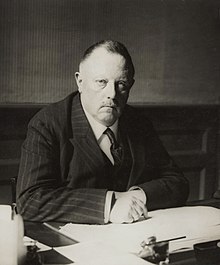Willem Hendrik Keesom
Willem Hendrik Keesom (born June 21, 1876 on Texel , Netherlands , † March 24, 1956 in Oegstgeest ) was a Dutch physicist .
Keesom was a farmer's son and studied at the University of Amsterdam . In 1904 he did his doctorate in Leiden with Heike Kamerlingh Onnes , whose research assistant he became and whose work on the liquefaction of helium he was involved. From 1917 to 1923 he taught at the veterinary school in Utrecht and from September 26, 1923 he was professor of experimental physics in Leiden, where he succeeded Kamerlingh Onnes in his laboratory.
His main field of work was low temperature physics . In 1926 he invented a method of solidifying helium by pressure, which his teacher Kamerlingh-Onnes, who first liquefied helium in 1908, had not succeeded. He also found signs of the phase transition to superfluidity of helium at the lambda point, and in 1932, together with Klaus Clusius, measured the anomaly of the course of the heat capacity at this phase transition. He also developed a mathematical theory of the dipole-dipole interaction ( Keesom interactions ).
With Kamerlingh Onnes he wrote an article Equations of State in the Encyclopedia of Mathematical Sciences .
In 1924 he was elected to the Royal Netherlands Academy of Sciences . In 1928 he was elected a member of the Leopoldina .

He married Anna Maria Aleida Moorman in 1904 and had two sons and a daughter with her. The daughter Anna Petronella and the son Piet Keesom (later professor at Purdue University and also low-temperature physicist) also became physicists, his daughter did his doctorate with him and he was a co-referee for his son's doctorate. The eldest son, Hendrik Willem, joined the army.
On July 5, 2001, the asteroid (9686) Keesom was named after him.
Web links
- Literature by and about Willem Hendrik Keesom in the catalog of the German National Library
- Wilhelmus Hendrikus Keesom 1876-1956 . In: Klaas van Berkel, Albert van Helden, Lodewijk Palm (Eds.): A History of Science in The Netherlands. Survey, Themes and Reference . Brill, Leiden / Boston / Cologne 1999, p. 498–500 (English, knaw.nl [PDF]).
- PH van Laer: KEESOM, Wilhelmus Hendrikus (1876-1956). Koninklijke Nederlandse Akademie van Wetenschappen, 2013 (Dutch).
- Wilhelmus Hendrikus Keesom. In: Biography portal of the Netherlands. (English).
| personal data | |
|---|---|
| SURNAME | Keesom, Willem Hendrik |
| BRIEF DESCRIPTION | Dutch physicist |
| DATE OF BIRTH | June 21, 1876 |
| PLACE OF BIRTH | Texel , Netherlands |
| DATE OF DEATH | March 24, 1956 |
| Place of death | Oegstgeest |
